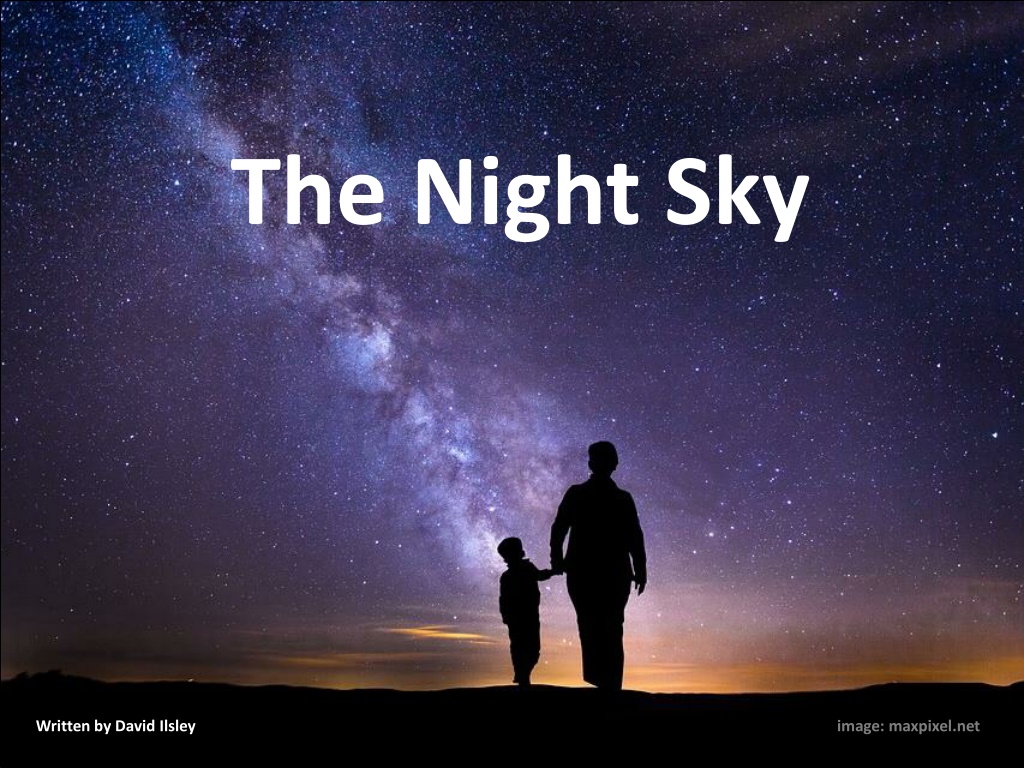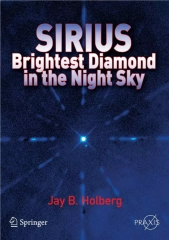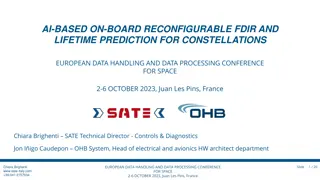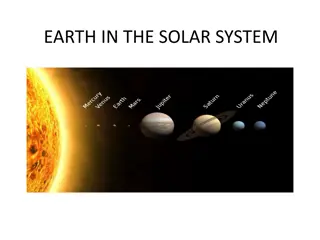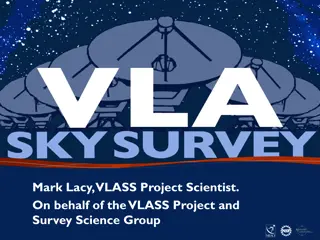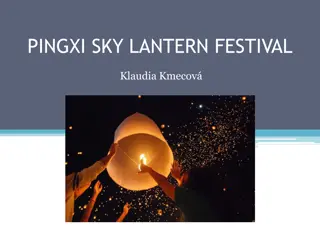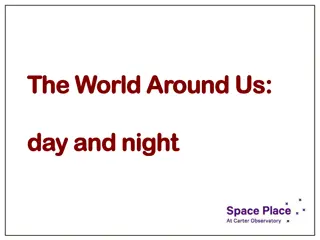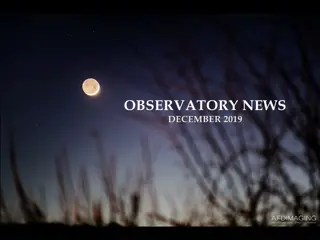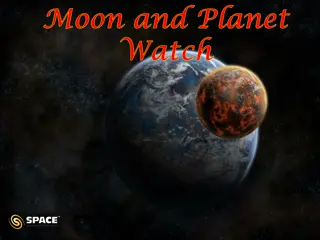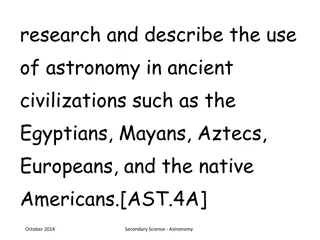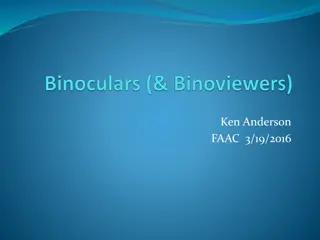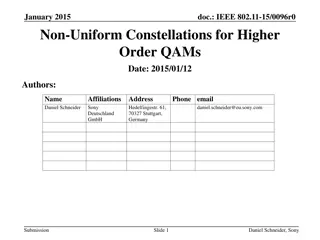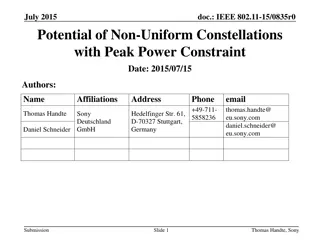Exploring the Enchanting Night Sky: A Journey Through Constellations
Delve into the mesmerizing world of stars and constellations, where the night sky reveals its celestial wonders. Discover the beauty of the cosmos, from the twinkling stars to the mystical shapes that form constellations, and learn how ancient observations have shaped our understanding of the universe.
Download Presentation

Please find below an Image/Link to download the presentation.
The content on the website is provided AS IS for your information and personal use only. It may not be sold, licensed, or shared on other websites without obtaining consent from the author. Download presentation by click this link. If you encounter any issues during the download, it is possible that the publisher has removed the file from their server.
E N D
Presentation Transcript
The Night Sky Written by David Ilsley image: maxpixel.net
This quality slideshow is brought to you by . . . Baboons image: flickr.com
Stars If a person with good eyesight looks at the sky on a clear night with no light pollution from cities, they can see about 3000 stars. Of course, there would be another 3000 similar stars below them, making about 6000 stars visible to the naked eye. image: publicdomainpictures.net
Near cities, however, there tends to be a lot of light pollution and often some haze pollution from traffic exhaust, industry etc. As a result, the number of stars visible is generally considerably less often less than 100. People from cities who go out to the outback tend to be amazed by the number of stars that can be seen on a clear moonless night. image: publicdomainpictures.net
As well as these stars, under good conditions the naked eye can see: the sun and the moon five planets, maybe six a few nebulae one or two globular clusters a few galaxies including our own, the Milky Way, and two satellite galaxies, the Magellanic Clouds. image: pixabay.com
For thousands of years, people have looked at the stars and seen shapes in them, like the tail of a scorpion in Scorpius. image: rawpixel.com image: commons.wikimedia.org
Or this small dog in Canis minor image: pixabay.com
These shapes are called constellations. Nowadays, astronomers divide the sky into 88 constellations. This gives a handy way to say which part of the sky you are talking about. image: commons.wikimedia.org
The stars in a constellation are given Greek letters starting with for the brightest one, then going through the Greek alphabet for progressively dimmer ones. . . . So the brightest star in Orion is Orionis, the second brightest is Orionis, etc. (Orionis is Latin for of Orion .)
The Greek Alphabet image: flickr.com
The brightest stars in the sky are also given proper names. Orionis is called Betelgeuse Orionis is called Rigel Orionis is called Bellatrix Canis majoris, the brightest star in the sky, is called Sirius. image: commons.wikimedia.org
None of these stars were named after characters from Harry Potter. They were mostly named by Arab astronomers around a thousand years ago. That s why some have funny names like Aldebaran, Mirphak and Zubenelgenubi. image: flickr.com
We describe the brightness of a star by its magnitude. Originally, the brightest stars were called first magnitude, the next brightest second magnitude, down to sixth magnitude for the dimmest stars visible to the naked eye. We now give stars a numerical magnitude, usually to two decimal places. In keeping with the original idea, magnitude 1 is brighter than magnitude 5. image: flickr.com
Magnitude 1 is 2.512 times brighter than magnitude 2, magnitude 2 is 2.512 times brighter than magnitude 3, magnitude 3 is 2.512 times brighter than magnitude 4, magnitude 4 is 2.512 times brighter than magnitude 5, and so on. 2.512 is a funny number. It is chosen because 2.5125 = 100 So, a change of 5 magnitudes is a change in brightness of 100 times.
Magnitudes can go beyond 6 to allow for stars only visible through telescopes, and can go to zero and negative numbers to allow for stars brighter than magnitude 1. image: commons.wikimedia.org The dimmest stars visible by eye are about magnitude 6; the dimmest stars distinguishable through telescopes are about magnitude 30; Sirius is magnitude 1.46; Venus can reach magnitude 4.6;
The full moon is about magnitude 12; and the Sun is about 27. image: commons.wikimedia.org
We can learn to recognise some constellations Here are Scorpius and Sagittarius All the sky pictures in this PowerPoint were generated using Stellarium
Test yourself on these.
Two very distinctive constellations in the northern hemisphere are: - Ursa major (the great bear), also called the plough or big dipper or saucepan, and - Cassiopeia, also called the W.
Strictly speaking, the plough is an asterism rather than a constellation. It is a distinctive pattern of stars, but it is only part of the great bear constellation.
In the same way, the teapot is an asterism, part of the constellation Sagittarius.
Scorpius, the teapot, the southern cross, Orion, Taurus, the plough and Cassiopeia are the constellations and asterisms that are very easy to spot. They have bright stars in recognisable patterns. Others constellations are less distinctive but many still have recognisable patterns. By becoming familiar with the star arrangements, we can learn to recognise these too.
Corvus Leo
Yet other constellations are hard to spot many consisting of just a few quite dim stars. The brightest star in the constellation Mensa, for example, is magnitude 5.2 not really visible in suburban skies. So, in general, the constellation can t be seen at all.
To describe where constellations are, it is helpful to have some reference points in the sky. The best one is the South Celestial Pole (or North Celestial Pole if you are in the Northern Hemisphere). This is the point in the sky which is directly above the South Pole. It is the direction in space in which the Earth s axis points. The same stars and galaxies that are at the SCP are always at the SCP.
Whats more, the SCP is always at the same position in the sky. If it is just above the top of a certain tree when you look out your bedroom window, it will be just above the same tree 6 hours or 6 months later. It never moves. SCP image: pixnio.com
There is a bright star called Polaris at the NCP. SCP But, unfortunately, there isn t at the SCP. The best way to locate the SCP in the sky is to use the Southern Cross and the Pointers ( and Centauri).
Imagine a line through the end stars of the Southern Cross. Then another line which is a perpendicular bisector of the line joining the Pointers ( and Centauri). Where these lines cross is roughly the South Celestial Pole. image: commons.wikimedia.org
Of course the SCP is always due south, so this is a way to find which way is south at night if you don t have a compass. image: rawpixel.com
As the Earth rotates, every star in the sky as well as the sun, the moon and the planets all move in clockwise circles around the SCP taking about 24 hours to go around once. image: flickr.com It is clockwise because, when looking down on the North Pole, the Earth rotates anti-clockwise. In fact looking down from above the North Pole, almost everything in the solar system rotates and orbits anticlockwise.
Stars near the SCP stay above the horizon the whole time. Stars further away dip below the horizon, rising in the east and setting in the west, just like the sun. image: flickr.com
image: flickr.com Stars on the celestial equator (those above the Earth s equator) seem to move in a fairly straight line across the sky. Those closer to the NCP move in anticlockwise circles around the NCP, which in the Southern Hemisphere is below the horizon.
The Earth rotates once every 23 hours and 56 minutes. It then takes another 4 minutes to turn that little bit further to be facing the sun again. image: commons.wikimedia.org So stars actually take only 23 h 56 min to circle the SCP. Thus they rise 4 minutes earlier each day.
After 6 months, the stars are rising 12 hours earlier. Thus you see a different set of stars in summer from what you do in winter (assuming that you look at the same time of night). image: commons.wikimedia.org
The planets and moons of the solar system all lie roughly in a plane called the ecliptic. Because the Earth s equatorial plane is tilted 23.5 relative to the ecliptic, the ecliptic is tilted 23.5 relative to the celestial equator. The plane of the Milky Way is tilted 63 relative to the celestial equator. As these rotate around the SCP, they sort of wobble in the sky in a way that s difficult to envisage. image: commons.wikimedia.org
The moon goes around the Earth in 27.3 days and it is 29.5 days from one full moon to the next. This was the origin of our month. image: commons.wikimedia.org
At new moon it is roughly between us and the sun and it rises and sets with the sun. At full moon it is opposite the sun and it rises as the sun is setting. Each day the moon rises about an hour later than the previous day. There is more about the moon in the PowerPoint titled The Moon . image: commons.wikimedia.org
The End We hope you enjoyed it. image: pixabay.com
